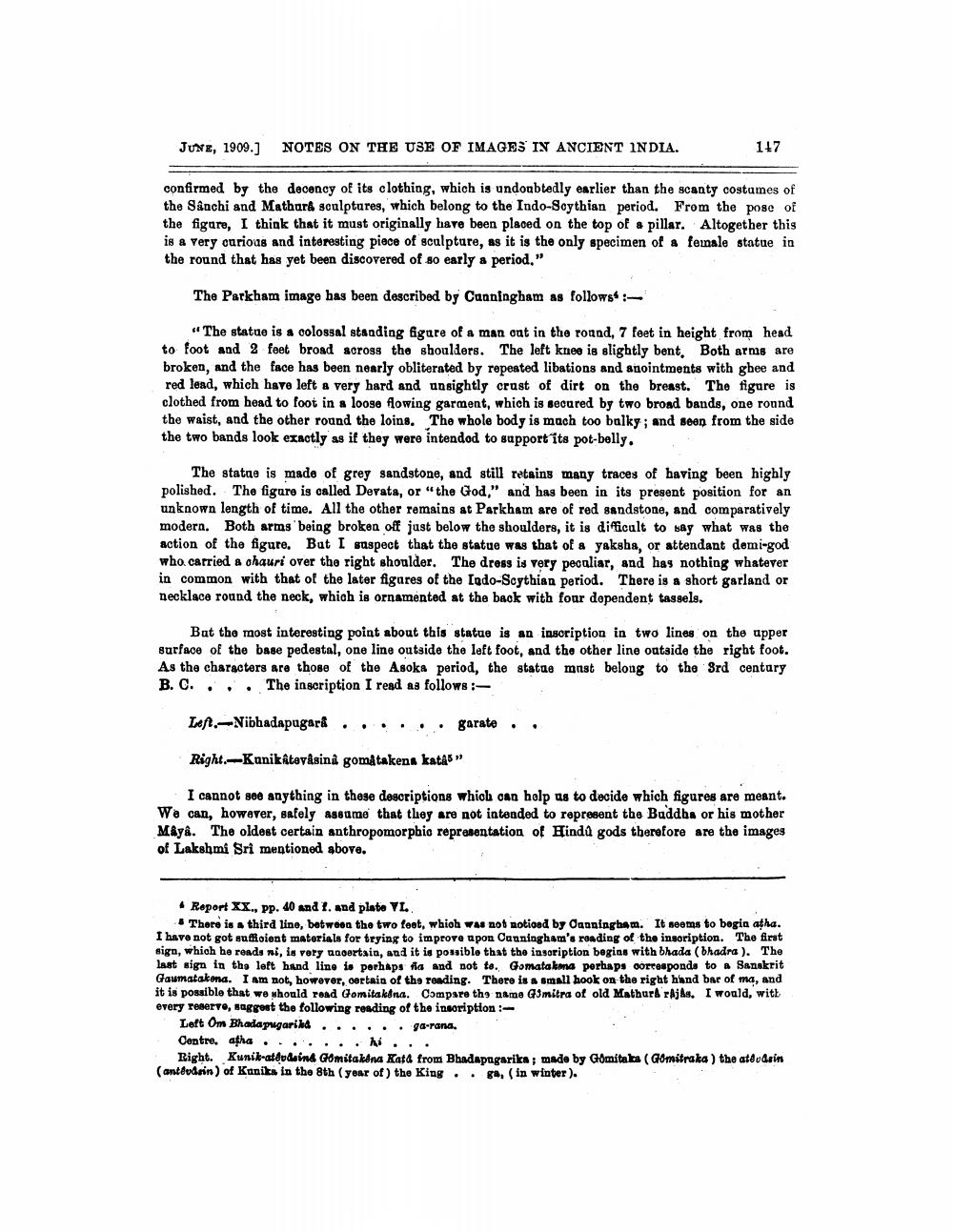________________
JUNE, 1909.] NOTES ON THE USE OF IMAGES IN ANCIENT INDIA.
117
confirmed by the decency of its clothing, which is undoubtedly earlier than the scanty costames of the Sanchi and Mathura sculptures, which belong to the Indo-Scythian period. From the pose of the figure, I think that it must originally have been placed on the top of a pillar. Altogether this is a very curious and interesting piece of sculpture, as it is the only specimen of a female statue in the round that has yet been discovered of 80 early a period."
The Parkham image has been described by Cunningham as follows:
“The statue is a colossal standing figure of a man out in the roand, 7 feet in height from head to foot and 2 feet broad across the shoulders. The left knee is slightly bent. Both arms are broken, and the face has been nearly obliterated by repeated libations and anointments with ghee and red lead, which have left a very hard and unsightly crust of dirt on the breast. The figure is clothed from head to foot in a loose flowing garment, which is secured by two broad bands, one round the waist, and the other round the loins. The whole body is much too balky; and seen from the side the two bands look exactly as if they were intended to support its pot-belly.
The state is made of grey sandstone, and still retains many traces of having been highly polished. The figure is called Devata, or "the God," and has been in its present position for an unknown length of time. All the other remains at Parkham are of red sandstone, and comparatively modern. Both arms being broken off just below the shoulders, it is difficult to say what was the action of the figure. But I suspect that the statue was that of & yaksha, or attendant demi-god who carried a chauri over the right shoulder. The dress is very peculiar, and has nothing whatever in common with that of the later figures of the Indo-Scythian period. There is a short garland or necklace round the neck, which is ornamented at the back with four dependent tassels.
Bat the most interesting point about this statue is an inscription in two lines on the upper surface of the base pedestal, one line outside the left foot, and the other line oatside the right foot. As the characters are those of the Asoka period, the statue must belong to the Srdcentury B. C.... The inscription I read as follows:
Left.-Nibhadapugara ...... garate..
Right--Kanikatevåsina gomåtakena katas
I cannot see anything in these descriptions which can help us to decide which figures are meant. We can, however, safely assume that they are not intended to represent the Buddha or his mother Maya. The oldest certain anthropomorphic representation of Hindu gods therefore are the images of Lakshmi Sri mentioned above.
• Report XX., PP. 40 and 1. and plate TL.
There is a third line, between the two feet, which was not noticed by Oanningham. It seems to begin atha. I have not got suficient materials for trying to improve upon Canningham's ronding of the insoription. The first sign, which he reads ni, is very noortsin, and it is possible that the insoription begins with bhada (bhadra). The laat sign in the left hand lino is perhaps fa and not te. Gomatalima perhaps corresponds to a Sanskrit Gaumatakona. I am not, however, certain of the reading. There is a small hook on the right hand bar of ma, and it is possible that we should read Gomitakana. Compare the name Gmitra of old Mathurd rajas. I would, with every reserve, saggout the following reading of the insoription :
Left Om Bhadapigarild...... ga-rana. Centre, afha ...... . .. .
Right. Kunik-atdodoins Gomitakana Kata from Bhadapagarika; made by Gömítala (Gomitraka) the atdodein (antudgin) of Kanits in the 8th (year of the King.. ga, (in winter ).




